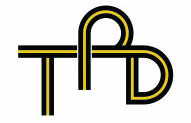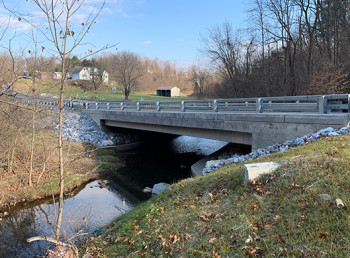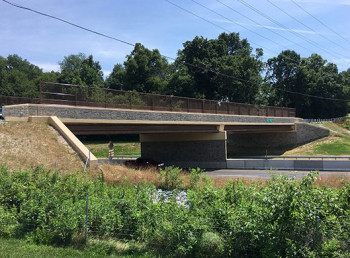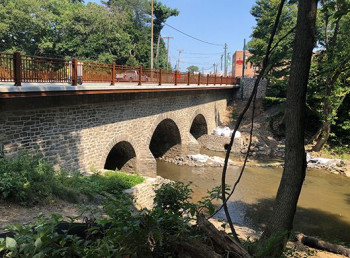Barnettstown Bridge Replacement (SR 0913, Section 06B) over Shoup Run
Carbon Township, Huntingdon County, PA
CLIENT
PennDOT District 9-0
1620 N. Juniata Street
Hollidaysburg, PA 16648
PROJECT COMPLETION DATE
December 2016
CONSTRUCTION COST
$4,000,000
PROJECT OVERVIEW
For this project, TPD designed the replacement of an existing, 79-year old, narrow, structurally deficient and functionally obsolete steel through-girder bridge. The existing bridge had a 74’ single span with a 55° skew across Shoup Run and the abandoned bed of the former Huntingdon and Broad Top Mountain Railroad. The bridge is a vital link on SR 0913 for access to Raystown Lake, a popular recreation area. The location of the bridge presented numerous design challenges due to site and design constraints, including:
- Maintaining traffic through the site during construction because the shortest detour was over 20 miles long
- A 40’ high structure from streambed to roadway grade
- Adjacent roadway intersections at each approach
- A truss bridge 20’ downstream carrying a sewer line
- A streambed grade exceeding 5% with high flow velocities and a history of bed erosion and head cuts
- Very high, steep streambed embankment slopes
- Remnant substructures from a previous highway bridge and railroad bridge
- Utility relocations
- Maintaining access to an active beverage store within the project limits
- High vertical rock cuts adjacent to the roadway along the north approach roadway and local businesses and residences fronting the roadway at the south approach
Various alternatives for replacing the structure were studied, including utilizing short term road closures and Accelerated Bridge Construction techniques, constructing a new structure beneath the existing bridge while maintaining traffic on the existing bridge, utilizing a temporary single lane bridge to maintain traffic, and half width, staged demolition and construction.
After evaluation of the various alternatives and site and design constraints, the half width, staged demolition and construction alternative was recommended. This alternative maintained a single lane of traffic throughout construction, kept the adjacent intersections open and maintained access to the beverage store. Temporary traffic signals were used to control traffic flow. Because the existing through‑girder bridge was a non-redundant structure, temporary support beams were installed beneath the bridge to allow half the structure to be removed while traffic was maintained on the other half. The height of the structure required significant temporary shoring to support the excavation for the new bridge.
The new bridge is a 70’ single span with a 55° skew and four prestressed concrete Bulb-T beams supported by a substructure of reinforced concrete abutments and wing walls. Bridge foundations were embedded in bedrock, with concrete and rock scour protection provided to resist the high stream flow velocities. A wider bridge was provided to meet current bridge width criteria, with a little extra width in one shoulder to permit the half width demolition and construction. The requirements for lane transition tapers for the temporary traffic control, coupled with the proximity of rock cuts on the north approach, limited the feasible width of the bridge, and required the minimum feasible space between the construction stages for the temporary excavation supports.
The tangent roadway alignment and profile were maintained across the new bridge, with improvements to the intersections at each end of the bridge. Careful design of the proposed bridge and intersections improved the sight distance from the intersection, which was previously limited by the through-girder bridge girder, and ensured adequate turning movements for trucks.
The proximity of the existing adjacent sewer bridge required that it be removed to enable construction of the new bridge. Therefore, the sewer line was relocated to be supported by the new roadway bridge. The height of the bridge allowed the sewer line to be hung below the beams of the new bridge and still well above the 100-year flood elevations. In addition to the sewer line, temporary and permanent utility relocations were required for electric and telecommunication facilities.





